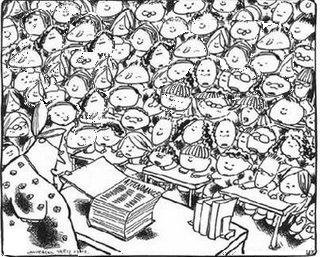Mike Klonsky’s SmallTalk Blog: Class Size: The Common Sense Bus Doesn't Stop on School Reform Blvd.
 Reformers say: "But there's no research on benefits of smaller class size." |
I'm increasingly confronted by some local, self-described school reformers who minimize the effects of rising class sizes on effective teaching and learning. "There's no research supporting smaller class size", they tell me. Of course, they are wrong.
But even showing them a pile of evidence, including the famous STAR study, doesn't seem to do much good. Actually, I don't think they are really into "looking at the data." Evidence seems to confuse or bore them. Instead they seem content to merely repeat what they hear from teacher-bashing, budget-slashing politicians like Mitt Romney or corporate-style reformers like Bill Gates and Secretary Arne Duncan, who claim that fewer, higher-paid teachers teaching larger classes is the solution to the budget crisis.
Higher teacher pay does sound nice. But, as you might expect in these difficult times, what we really end up with are massive increases in class size, downward pressure on teacher pay and our best, most experienced teachers being replaced by cheaper newbies or TFAers.
My argument now has been reduced to an appeal to common sense. I say, just try teaching a kindergarten class with 51 children or a first-grade room with 48 kids likes the ones at Avalon Park Elementary, a school with nearly all African-American kids from low-income families on Chicago's south side. I don't care how accomplished an early-childhood teacher you are, you are being set up to fail.
Unfortunately, the common sense bus no longer stops on School Reform Blvd.
The numbers cited above are not isolated examples but typify the conditions for thousands of CPS students who started this year in grossly overcrowded classrooms and will likely face even worse conditions in the coming school year. They come from a new report from Sarah Karp at the Better Government Association (BGA) who writes:
System-wide, about 1,600 elementary classrooms – or about 20 percent of the nearly 8,500 non-charter elementary classrooms in the 2014-2015 school year – exceeded CPS’ own standards, the BGA found. Two-thirds of those overcrowded classrooms are on the South and West sides. About half have 90 percent or more low-income students.
There are no formal penalties for exceeding classroom size standards.
Even though the teachers union is technically barred under recent legislation from negotiating down class size, you can bet that it’s an issue at the center of current contract negotiations.
CTU Vice President Jesse Sharkey says,
"We are worried about [CPS] devastating class sizes. We are worried about them herding students into classes, like animals into stockyards. We are looking for some assurances, especially in the lower levels."
At some point, I'm hoping the reformers will be forced to come to their senses. More research probably won't do it. But maybe growing community anger will.
After all, even the neo-confederates in South Carolina have now agreed to take down that flag.
This blog post has been shared by permission from the author.
Readers wishing to comment on the content are encouraged to do so via the link to the original post.
Find the original post here:
The views expressed by the blogger are not necessarily those of NEPC.

